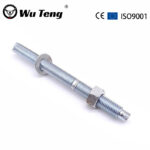
Products
Chemical anchor bolt
Chemical anchor bolt is a new type of fastening material composed of chemical agents and metal rods. Can be used for the installation of post embedded parts in various curtain wall and marble dry hanging construction, as well as for equipment installation, highway and bridge guardrail installation; In occasions such as building reinforcement and renovation. Due to the flammable and explosive chemical reagents contained in its glass tube, the manufacturer must obtain approval from relevant national departments before production. The entire production process requires strict safety measures and must use an assembly line completely isolated from the workers. If manual work is done, it not only violates relevant national regulations, but also is very dangerous. Chemical anchor bolt is a new type of anchor bolt that emerged after expansion anchor bolt. It is a composite component that uses a special chemical adhesive to bond and fix the screw in the drilled hole of the concrete substrate, in order to anchor the fixed part. The product is widely used in fixed curtain wall structures, installation machines, steel structures, railings, windows, etc.
Characteristics: 1. Acid and alkali resistance, low temperature resistance, and aging resistance;
2. Good heat resistance and no creep at room temperature;
3. Waterproof to stains and stable long-term load in humid environments;
4. Good welding resistance and flame retardancy;
5. Good seismic performance.
Application areas: 1. Suitable for fixing heavy loads on close and narrow components (columns, balconies, etc.).
2. Can be used in concrete (=>C25 concrete).
3. Can be anchored in pressure resistant natural stones (untested).
4. Suitable for anchoring the following: steel reinforcement, metal components, trailers, machine substrates, road guardrails, formwork fixation, soundproof wall foot fixation, road sign fixation, sleeper fixation, floor slab edge protection, heavy-duty support beams, roof decoration components, windows, protective nets, heavy-duty elevators, floor slab support, construction support fixation, transmission system, sleeper fixation, support and shelving system fixation, anti-collision facilities, car trailers, pillars, chimneys, heavy-duty billboards, heavy-duty soundproof walls, heavy-duty doors fixation, complete equipment fixation, tower crane fixation, pipeline fixation, heavy-duty trailers, guide rails fixation, nail plate connection, heavy-duty space division devices, shelves, sunshades Fixed.
5. Stainless steel A4 anchor bolts can be used outdoors, in damp spaces, in industrial pollution areas, and in nearshore areas.
6. Galvanized steel and stainless steel A4 are not suitable for damp spaces containing chlorine (such as indoor swimming pools, etc.).
7. Suitable for fixing substrates with small wheelbase and multiple anchoring points.
Usage: 1. According to the engineering design requirements, drill holes at corresponding positions in the substrate (such as concrete), and the aperture, depth, and bolt diameter should be determined by professional technicians or on-site tests.
2. Use an impact drill or water drill to drill holes.
3. Use a dedicated air cylinder, brush, or compressed air machine to clean the dust in the borehole. It is recommended to repeat the process no less than 3 times, and there should be no dust or visible water inside the borehole. 4. Ensure that the bolt surface is clean, dry, and free of oil stains.
5. Confirm that the glass tube anchoring package has no abnormal phenomena such as appearance damage or solidification of chemicals, and place its round head inward into the anchoring hole and push it to the bottom of the hole.
6. Use an electric drill and specialized installation fixture to forcefully rotate and insert the screw until it reaches the bottom of the hole, without using impact methods.
7. When it is screwed to the hole bottom or the marked position on the bolt, stop the rotation immediately, take down the installation fixture, and avoid disturbance after gel is completely cured. Overtime rotation causes loss of adhesive and affects anchoring force.
| Thread Size | Anchor Length(mm) | Max Fixture Thickness(mm) | Min Embedment (mm) | Weight Kgs/1000pcs |
| M8-P1.25 | 110 | 15 | 80 | 35 |
| M10-P1.5 | 130 | 20 | 90 | 66 |
| M12-P1.75 | 160 | 25 | 110 | 127 |
| M16-P2.0 | 190 | 40 | 125 | 284 |
| M20-P2.5 | 260 | 60 | 170 | 592 |
| M24-P3.0 | 300 | 60 | 210 | 988 |
| M30-P3..0 | 380 | 60 | 280 | 1920 |









